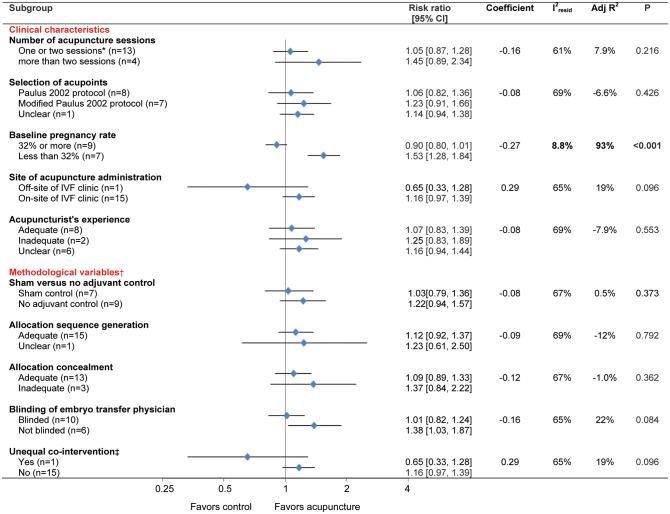Figure 2.
Meta-regression subgroup analyses for the primary outcome (i.e. clinical pregnancy). The quadrilaterals represent pooled estimates from the trials included in the given subgroup. The estimated regression coefficient from each model was obtained by a weighted least squares meta-regression with RR of pregnancy as the dependent variable, using the modification to the variance of the estimated coefficient suggested by Knapp and Hartung (2003), and supported by Higgins and Thompson (2004).  values indicate the proportion of the residual variation that is attributable to between-study heterogeneity. The adjusted R2 values indicate the proportion of between-study variance explained by the covariate. The P-values for test of interaction indicate whether the observed differences in results of trials within a given subgroup are compatible with chance alone. *The So 2010 trial was the only trial that used only one acupuncture treatment session. The Westergaard 2006 trial had two acupuncture treatment arms, one arm received two sessions and the other arm received three, and these arms were grouped separately for this subgroup analysis. †Incomplete outcome data were also prespecified as a methodological subgroup variable, but no trial had a high risk of bias due to incomplete outcome data for the clinical pregnancy outcome. ‡Only the Craig et al. trial was judged to have a co-intervention that was applied unequally across treatment group. Namely, in this trial, which evaluated off-site acupuncture, patients in the acupuncture group only were required to drive to and from the off-site acupuncturist's office both before and after the embryo transfer procedure.
values indicate the proportion of the residual variation that is attributable to between-study heterogeneity. The adjusted R2 values indicate the proportion of between-study variance explained by the covariate. The P-values for test of interaction indicate whether the observed differences in results of trials within a given subgroup are compatible with chance alone. *The So 2010 trial was the only trial that used only one acupuncture treatment session. The Westergaard 2006 trial had two acupuncture treatment arms, one arm received two sessions and the other arm received three, and these arms were grouped separately for this subgroup analysis. †Incomplete outcome data were also prespecified as a methodological subgroup variable, but no trial had a high risk of bias due to incomplete outcome data for the clinical pregnancy outcome. ‡Only the Craig et al. trial was judged to have a co-intervention that was applied unequally across treatment group. Namely, in this trial, which evaluated off-site acupuncture, patients in the acupuncture group only were required to drive to and from the off-site acupuncturist's office both before and after the embryo transfer procedure.

